Four modifications for the Raft consensus
algorithm
Henrik Ingo
henrik.ingo@openlife.cc
September 2015
1. Background
In my work at MongoDB, I've been involved in a team that is adapting our replication protocol to
conform to the principles set out in the academic paper that describes the Raft algorithm(Ongaro,
2014). Breaking with the academia's long standing obsession with Paxos, of which I'm yet to hear
about a robust real world and open source implementation, Raft describes a simple, easy to
understand leader based consensus algorithm. (In the vocabulary used outside of academia,
Raft describes a singlemaster, synchronous replication protocol using majority elections.)
Hence, while my original interest in Raft is purely work related, clearly it is meaningful to
consider Raft itself as a valuable contribution to the brittle art of making databases highly
available. As such, this paper is written purely within the context of Raft itself, without any
reference to the replication implementation in MongoDB, and ignoring the multitude of
differences that a MongoDB implementation will have compared to Raft. (One of which is
MongoDB being pull based, while Raft is a push based algorithm.)
This is the second version of this paper and supersedes its predecessor from a month ago,
which was called "Three modifications for Raft consensus". This version adds an explicit cluster
initialization step, hence making it four modifications. Adding the cluster initialization as an
explicit part of the algorithm, makes the description of the database id more straightforward. As
part of simplifying the creation of the database id, this paper no longer proposes the option to
automatically delete old data from a server this was seen as a an unsafe operation by several
reviewers of the first version and therefore became cause for much unnecessary confusion . For
the benefit of those who already read the previous version, the new and changed parts of this
paper are colored dark red.
1
I would like to particularly thank Oren Eini for his thorough review of the first version of this
paper and for proposing to codify the cluster initialization to a more explicit part of the algorithm.
1 https://groups.google.com/forum/#!topic/raftdev/2OGYyUmjRFY
© 2015 by MongoDB Inc. © 2014 by Diego Andres Ongaro. (RPC call tables)
This work is licensed under a Creative Commons Attribution3.0 License.
http://creativecommons.org/licenses/by/3.0/
1
�
2. Introduction
The major contribution of the Raft authors has clearly been to finally introduce an easy to
understand, easy to implement protocol for distributed consensus. While more complicated
protocols may offer additional value in terms of feature set such as supporting a multimaster
scheme it is a valuable resource for the community of distributed databases to at least have a
robust alternative for the most basic kind of replication, leader based consensus. Somewhat
surprisingly, the level of elegance achieved by Raft has not been clearly documented
previously, let alone provided with proofs of correctness. The closest, and compared to Paxos
rather useful, cousin to Raft would be the family of ViewStamped replication algorithms(Oki & Liskov,
1988), however Raft significantly simplifies compared to ViewStamped replication.
It is common for academic papers to focus mostly on the core replication of events themselves,
and the closely related mechanism of electing a leader or determining a quorum. On the other
hand they commonly neglect important surrounding topics, such as cluster maintenance
activities or "environmental corner cases", that in the real world are equally important
ingredients in creating a complete solution for a highly available database.
Also the Raft algorithm has evolved in similar fashion. This is evident when following the
succession of published papers from the original Usenix 2014 paper(Ongaro & Ousterhout, Usenix 2014) to
the extended version of the same paper(Ongaro & Ousterhout, 2014) to the thesis by Diego Ongaro
published later in 2014(Ongaro, 2014).
For example, the original Usenix paper did not include any mention of snapshotting the state
machine, rather simply describes an indefinitely growing log of events clearly not realistic for
most real world systems that might implement Raft, including the authors' own Ramcloud
database. The extended version then added a discussion on snapshotting, including an
InstallSnapshot RPC for sending the snapshot to followers when needed.
Similarly the original Usenix paper does include a discussion on cluster membership changes,
but it is obvious even to the casual reader that this part of the paper did not receive the same
amount of thought that went into the core of the algorithm, and certainly does not achieve the
simplicity goal the authors had set themselves. Ultimately the cluster membership change
protocol ends up in the curious state where members of the cluster are receiving (and
accepting!) events from a leader that's not even part of the current cluster. The Ongaro thesis
then replaces that complexity with 2 very simple RPCs to add and remove servers one at a time.
And as is often the case, the simpler algorithm also turns out to be more robust than the
complex one!
In the same spirit of evolving from a core protocol to a more complete and realistic
implementation, the goal of this paper is to introduce 4 modifications to Raft, that are relevant to
realworld distributed databases:
2
�
1. Cluster initialization: A cluster initialization step that is the starting point of the lifecycle of
the cluster. Having this step explicitly described makes it more straightforward to
describe also the database id, and their relation to AddServer RPC.
2. Universally Unique Database Identifier: to identify whether a snapshot or a log on one
server is in fact some (predecessor or successor) state of the same state machine on
other servers of the cluster, or whether it's a snapshot of some completely different state
machine that has nothing to do with this cluster.
3. Prevote algorithm: this paper provides a more detailed specification of the idea
suggested only in passing in §9.6 in (Ongaro, 2014)
4. Leader stickiness: Building on the prevote algorithm, we also modify Raft to reject
servers that attempt to elect themselves as leader, if the current leader appears to still
be healthy to the rest of the cluster. This is to avoid flipflopping between two competing
leaders.
The proposed modifications in this paper are written against the most recent publication of Raft,
Diego Ongaro's thesis paper(Ongaro, 2014), which the reader is assumed to be familiar with. The
tables summarizing the algorithm have been reproduced on the next few pages. The additions
of this paper are highlighted in blue.
InitializeCluster (NEW)
Called on a single server that becomes the first member of a
new cluster.
Set state:
databaseId
currentTerm if unset, set 0
log[]
After initialization, move to follower state (then elect yourself
to leader).
keep current contents (which may be nothing)
generate a universally unique id
State
Persistent state on all servers:
(Updated on stable storage before responding to RPCs)
databaseId
unique, constant identifier generated by
InitializeCluster.
currentTerm latest term server has seen (initialized to
votedFor
log[]
0, increases monotonically)
candidateId that received vote in current
term (or null if none)
log entries; each entry contains command
for state machine, and term when entry
was received by leader (first index is 1)
Volatile state on all servers:
commitIndex index of highest log entry known to be
committed (initialized to 0, increases
monotonically)
lastApplied index of highest log entry applied to state
machine (initialized to 0, increases
monotonically)
Volatile state on all leaders:
(Reinitialized after election)
nextIndex[]
for each server, index of the next log entry
to send to that server (initialized to leader
last log index + 1)
matchIndex[] for each server, index of highest log entry
known to be replicated on server
(initialized to 0, increases monotonically)
3
�
AppendEntries RPC
new ones
leaders term
so follower can redirect clients
Invoked by leader to replicate log entries (§3.5), also
used as heartbeat (§3.4).
Arguments:
term
leaderId
prevLogIndexindex of log entry immediately preceding
prevLogTermterm of prevLogIndex entry
entries[]
leaderCommitleader's commitIndex
Results:
term
success
log entries to store (empty for heartbeat;
may send more than one for efficiency)
currentTerm, for leader to update itself
true if follower contained entry matching
prevLogIndex and prevLogTerm
Receiver implementation:
1. Reply false if term < currentTerm (§3.3)
2. Reply false if log doesn't contain an entry at
3.
prevLogIndex whose term matches prevLogTerm
(§3.5)
If an existing entry conflicts with a new one (same
index but different terms), delete the existing entry
and all that follow it (§3.5)
4. Append any new entries not already in the log
5.
If leaderCommit > commitIndex, set commitIndex =
min(leaderCommit, index of last new entry)
AddServer RPC
Invoked by admin to add a server to the cluster
configuration.
Arguments:
newServer
databaseId
address of server to add to configuration
the universally unique databaseId of the
cluster to which the new server is added.
OK if server was added successfully
address of recent leader, if known
Results:
status
leaderHint
Receiver implementation:
1. Reply NOT_LEADER if not leader (§6.2)
2.
If newServer.databaseId is set, and
leader.databaseId != newServer.databaseId, reply
with error and instruct admin to reset the new server
to uninitialized state (e.g. delete database).
4
Rules for Servers
All servers:
●
●
If commitIndex > lastApplied: increment lastApplied,
apply log[lastApplied] to state machine (§3.5)
If RPC request or response contains term T >
currentTerm: set currentTerm = T, convert to follower
(§3.3)
Followers (§3.4):
● Respond to RPCs from candidates and leaders
●
If election timeout elapses without receiving
AppendEntries RPC from current leader or granting vote
to candidate: call PreVote RPC
Candidates (§3.4)
● On conversion to candidate, start election:
Increment currentTerm
Vote for self
Send RequestVote RPCs to all other servers
○
○
○ Reset election timer
○
If votes received from majority of servers: become leader
If AppendEntries RPC received from new leader: convert
to follower
If election time elapses: start new election
●
Leaders:
● Upon election: send initial empty AppendEntries RPC
●
●
●
●
●
(heartbeat) to each server, repeat during idle periods to
prevent election timeouts (§3.4)
If command received from client: append entry to local
log, respond after entry applied to state machine (§3.5)
If last log index >= nextIndex for a follower: send
AppendEntries RPC with log entries starting at nextIndex
If successful: update nextIndex and matchIndex for
○
follower (§3.5)
If AppendEntries fails because of log inconsistency:
decrement nextIndex and retry (§3.5)
○
If there exists an N such that N > commitIndex, a
majority of matchIndex[i] >= N, and log[N].term ==
currentTerm: set commitIndex = N (§3.5, §3.6)
RemoveServer RPC
address of server to remove from configuration
Invoked by admin to remove a server from the cluster
configuration.
Arguments:
oldServer
Results:
status
leaderHint
Receiver implementation:
1. Reply NOT_LEADER if not leader (§6.2)
2. Wait until previous configuration in log is committed
OK if server was removed successfully
address of recent leader, if known
3. Append new configuration entry to log (old configuration
without oldServer), commit it using majority of new
configuration (§4.1)
4. Reply OK and, if this server was removed, step down
(§4.1)
(§4.2.2)
�
InstallSnapshot RPC
Invoked by leader to send chunks of a snapshot to a follower.
Leaders always send chunks in order. AddServer may call
InstallSnapshot also to copy an empty initial state, in this
case zero bytes are transferred, but the state is synced.
Arguments:
term
leaderId
lastIndex
leader's term
so follower can redirect clients
the snapshot replaces all entries up to and
including this index
term of lastIndex
latest cluster configuration as of lastIndex
(include only with first chunk)
byte offset where chunk is positioned in the
snapshot file
raw bytes of the snapshot file, starting at
chunk
true if this is the last chunk
lastTerm
lastConfig
offset
data[]
done
Results:
term
currentTerm, for leader to update itself
Receiver implementation:
1. Reply immediately if term < currentTerm
2. Create new snapshot file if first chunk (offset is 0)
3. Write data into snapshot file at given offset
4. Reply and wait for more data chunks if done is false
5.
If lastIndex is larger than latest snapshot's, or if lastIndex
and lastTerm are zero, save snapshot file and Raft state
(databaseId, lastIndex, lastTerm, lastConfig). Discard
any existing or partial snapshot.
If existing log entry has same index and term as
lastIndex and lastTerm, discard log up to through
lastIndex (but retain any following entries) and reply
7. Discard the entire log
8. Reset state machine using snapshot contents (and load
6.
lastConfig as cluster configuration)
3.
If newServer.databaseId is unset, set it to
leader.databaseId, also set currentTerm and
log.index to 0.
4. Catch up new server for fixed number of rounds.
Reply TIMEOUT if new server does not make
progress for an election timeout or if the last round
takes longer than the election timeout. (§4.2.1)
5. Wait until previous configuration in log is committed
(§4.1)
6. Append new configuration entry to log (old
configuration plus newServer), commit it using
majority of new configuration (§4.1)
7. Reply OK
Raft State for Compaction
Persisted before discarding log entries. Also sent from
leader to slow followers when transmitting state.
prevIndex
index of last discarded entry (initialized to
0 on first boot)
term of last discarded entry (initialized to 0
on first boot)
the unique identifier for this database
latest cluster membership configuration up
through prevIndex
prevTerm
databaseId
prevConfig
PreVote RPC (NEW)
caller's term + 1
Called by a server before changing itself to Candidate
status. If a majority of servers return true, proceed to
Candidate. Otherwise, wait for another election timeout.
Arguments:
nextTerm
candidateId caller
lastLogIndex index of caller's last log entry
lastLogTerm term of caller's last log entry
Results:
term
voteGranted true means caller would receive vote if it
currentTerm, for caller to update itself
was a candidate
Receiver implementation:
1. Reply false if last AppendEntries call was received
less than election timeout ago (leader stickiness)
2. Reply false if nextTerm < currentTerm
3.
If caller's log is is at least as uptodate as receiver's
log, return true
5
�
RequestVote RPC
candidate's term
Invoked by candidates to gather votes (§3.4).
Arguments:
term
candidateId candidate requesting vote
lastLogIndex index of candidate's last log entry (§3.6)
lastLogTerm term of candidate's last log entry (§3.6)
Results:
term
voteGranted true means candidate received vote
Receiver implementation:
1. Reply false if last AppendEntries call was received
currentTerm, for candidate to update itself
less than election timeout ago (leader stickiness)
2. Reply false if term < currentTerm (§3.3)
3.
If votedFor is null or candidateId, and candidate's log
is at least as uptodate as receiver's log, grant vote
(§3.4, §3.6)
Figure 1: Summary of the Raft algorithm, from (Ongaro, 2014). References to a section (like
§3.4) reference sections in (Ongaro, 2014). Additions proposed in this paper are highlighted in
blue. InitializeCluster and PreVote RPC are new in their entirety, though the idea of a PreVote
was suggested in (Ongaro, 2014).
3. Cluster Initialization
A real world implementation of Raft, or any other consensus protocol, would of course have
some kind of bootstrap procedure, that will execute multiple actions to initialize the state of a
new cluster. Arguably, such a bootstrap sequence is clearly implied in (Ongaro, 2014), as the
state is set to some default values "at first boot".
However, reviewers of previous versions of this paper pointed out that the descriptions of a
databaseId and the closely related AddServer RPC would benefit from having an explicit
initialization step as part of the Raft algorithm. In addition, the discussion resulted in a
consensus that all real world implementations we are familiar with, actually have an initialization
sequence that does exactly the steps we will document here. (Of course a real world
implementation would still do a number of other initialization tasks that will still not be relevant to
describe as part of Raft.)
The cluster initialization step is simple yet profound. When a server starts, it is incapable of
becoming a leader and hence incapable of processing any events from client. The server must
either join an existing cluster via an AddServer call, or explicitly become a new cluster with
InitializeCluster.
6
�
If InitializeCluster is called on a server, it will generate a new databaseId (see next section) and
also set any other state variables to their default values. Note that after initialization, the server
will itself be a majority of a cluster with 1 server, so it will proceed to elect itself as a leader.
InitializeCluster marks the starting point of the lifecycle of a Raft cluster and state machine. The
life cycle ends when the last server is removed (or rather, removes itself) from the cluster. In
practice the lifecycle is more likely to end simply with the servers being shut down, never to be
restarted again.
However, it is also allowed to call InitializeCluster on a server that is already part of an initialized
cluster (that has one or more members). This could be necessary for a number of reasons. In
the Raft algorithm itself, it is for example possible to get into a state where a majority of servers
have been lost permanently. The cluster is now without a leader and will not be able to accept
new events from clients, and also will not be able to elect a new leader. Without a leader it is
also impossible to correct the situation, since AddServer and RemoveServer should be called
on the leader.
In such cases the solution is to call InitializeCluster again, essentially starting a new cluster from
the remains of the one that was just lost. As the databaseId is now regenerated, this also helps
prevent split brain. Or, in the case that the admin would call InitializeCluster on multiple parts of
the lost cluster, they would still split into separately identifiable parts, each with their own distinct
databaseId.
Therefore, when calling InitializeCluster, the server may or may not be empty of data. If there
already is some data on the server, the currentTerm and log index are preserved, but they
should be interpreted as the starting point in the lifecycle of a new cluster and detached from the
cluster they previously belonged to the log now lives irrevocably in a parallel history.
Note that for the other route for a server to become part of a Raft cluster, via the AddServer call,
the opposite is true: The server must either already be in a state with a matching databaseId or
it must be in the empty and uninitialized state. It is not allowed to add a server that contains
some unrelated data (or state) the administrator would have to first delete such database/state
from the new server.
Note that in the algorithm description above, we have specified InitializeCluster as an operation
that can only be called on a single server, which then becomes the sole member of its new
cluster. This is mostly an artefact of the way Raft is designed: it is always the Leader (or
sometimes a Candidate) that makes Remote Procedure Calls toward followers. But there is no
procedure where followers call to each other.
For real world implementations it may be desirable in particular to avoid unnecessary
InstallSnapshot calls, which are expensive on large snapshot files to allow a minority of
servers, still connected to each other, to enter into the new cluster together, rather than
initializing a single server first and then readding the others with AddServer RPC. This use
case is in fact implicitly supported: After calling InitializeCluster on the first server, it would be
7
�
possible to copy the newly generated databaseId to any other servers one would want to bring
into the new cluster. For example, an implementation may provide some kind of setDatabaseId()
call for this purpose. Note that this would definitively be considered an "admin forceful override"
type of operation. The admin would only use this in unusual circumstances and must be sure to
only call it on nodes that actually share the same log history with the server the databaseId is
copied from. After setting the databaseId on a second server, it could then join the first server's
cluster normally via an AddServer call. Since the databaseId's of the servers match, the
AddServer call will succeed without an InstallSnapshot operation.
4. Universally Unique Database Identifier
While the Raft algorithm as published in (Ongaro, 2014) does a great job in maintaining the
integrity of a single replicated state machine, in the real world database clusters don't live in a
vacuum. A sysadmin will be operating multiple servers in one or more datacenters, each server
belonging to some cluster. Failing to take this obvious fact into account, implementations will
often be left vulnerable to various split brain conditions, especially due to operational errors
such as misconfiguration. While we could blame many of these conditions on the sysadmin, it is
actually simple for an implementation to protect against such errors, and one should of course
therefore do so.
To illustrate a simple path to a split brain, one out of many possible, consider a 2 server cluster
and the following steps, that are fully legitimate operations as defined in the (Ongaro, 2014)
version of Raft:
Figure 2: Sequence of steps leading to split brain, which goes undetected:
a) Two servers S1 and S2 form the cluster, with S1 being the leader. They commit
x<1 and y<2, after which there is a network split. Since neither server alone is a
majority, there is no leader and replication stops. At this point both servers have
(term=1, index=2).
b) To get the service back into available state, the sysadmin has to change the
cluster configuration by calling S1.RemoveServer(S2). (Strictly speaking this can
only be called on the leader, however since it is not possible for any server to
become leader in this state, a real world implementation would provide or the
8
�
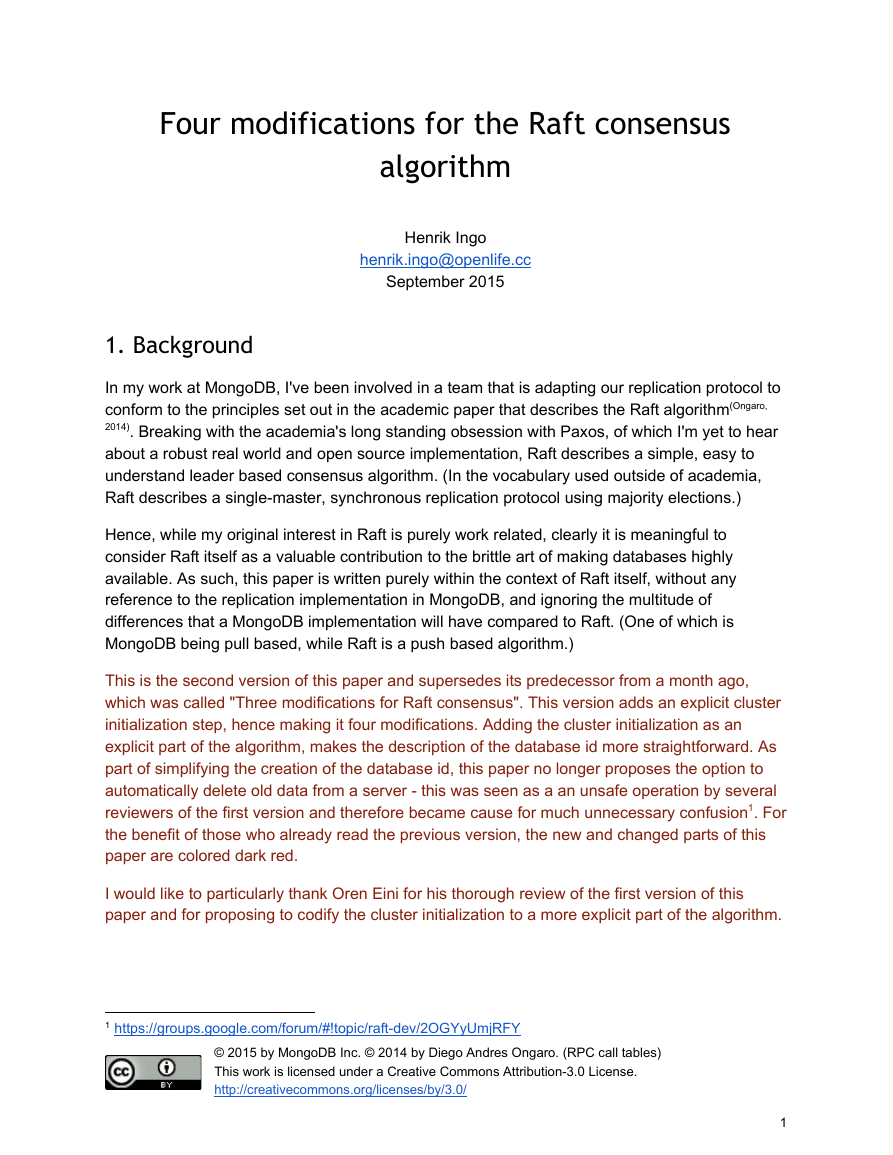
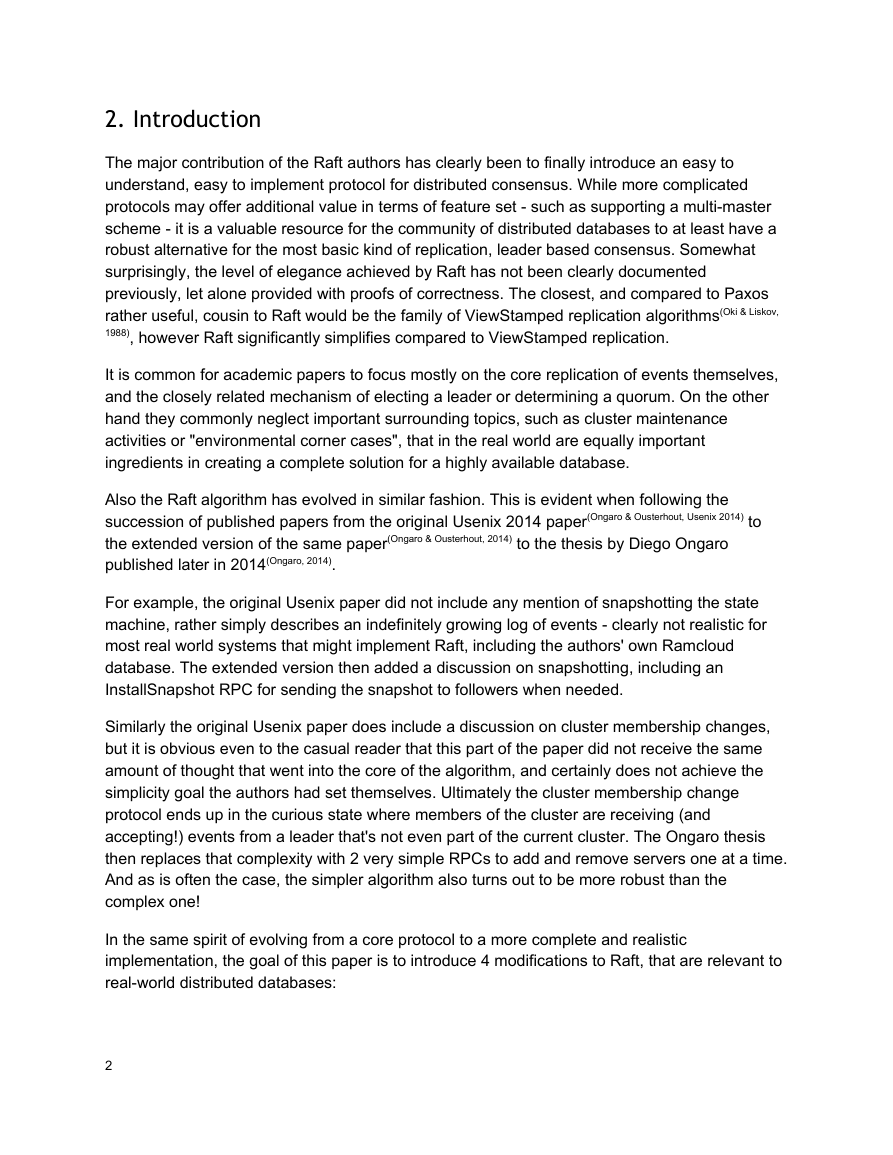
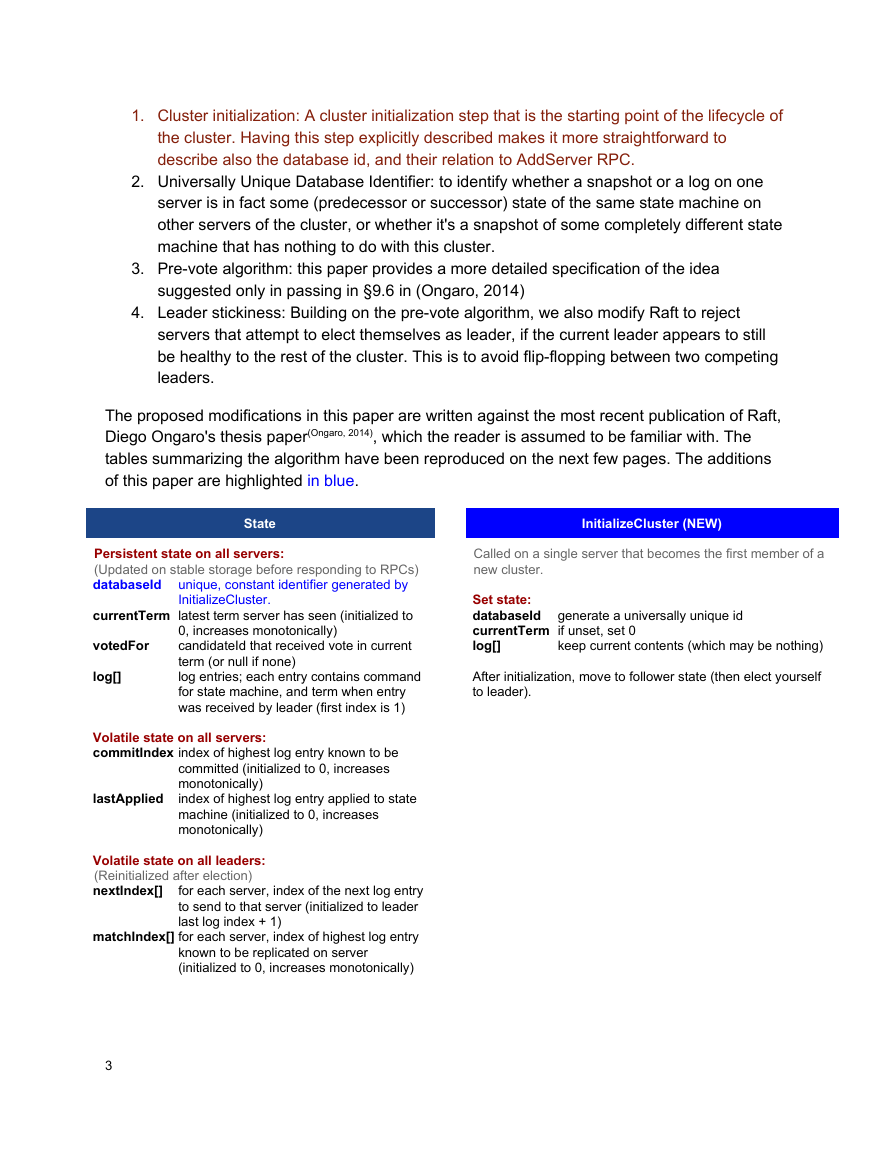
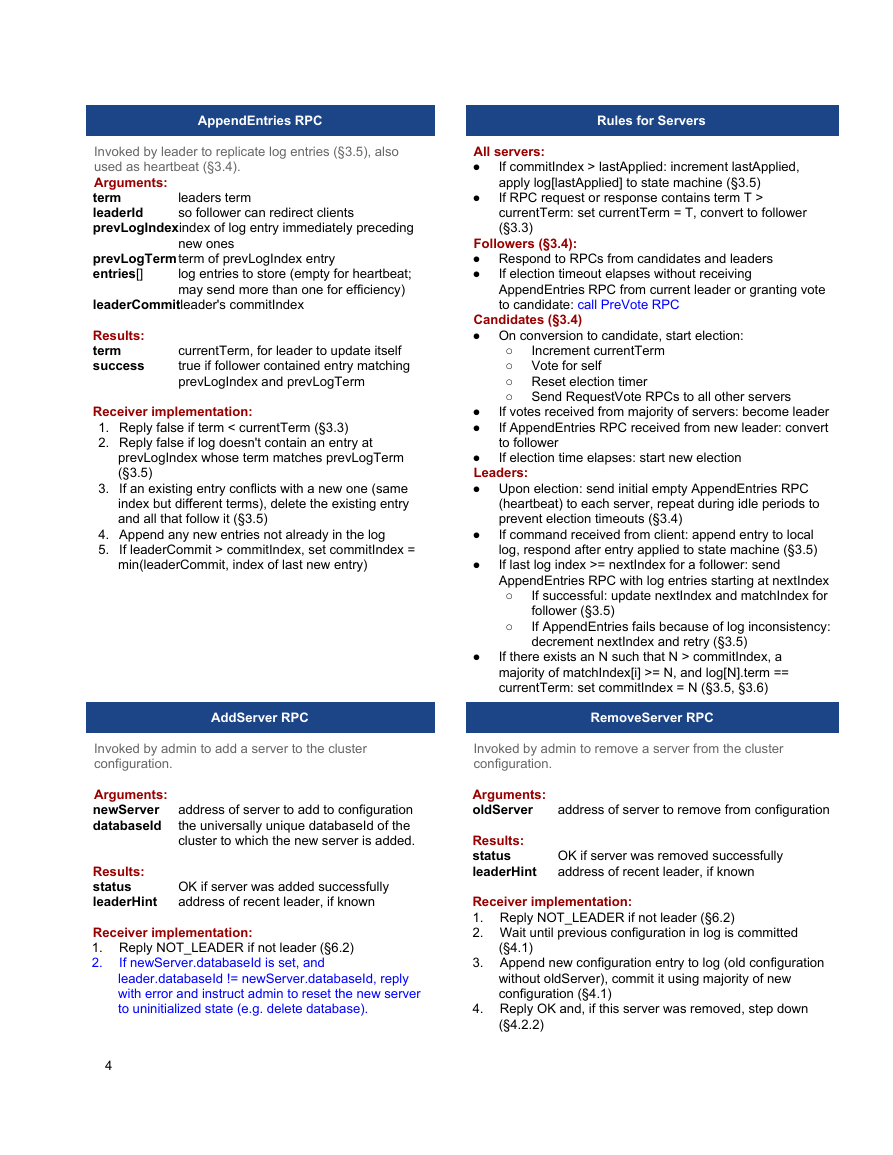
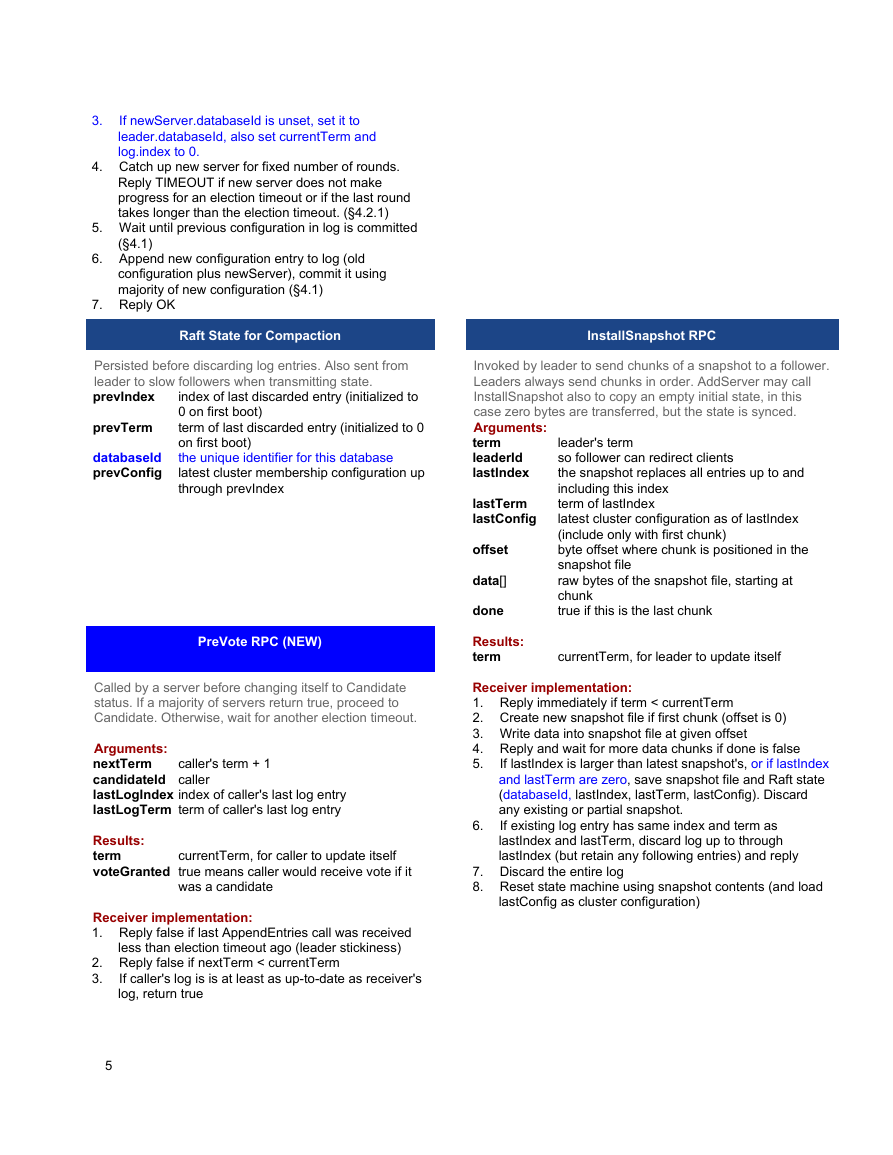
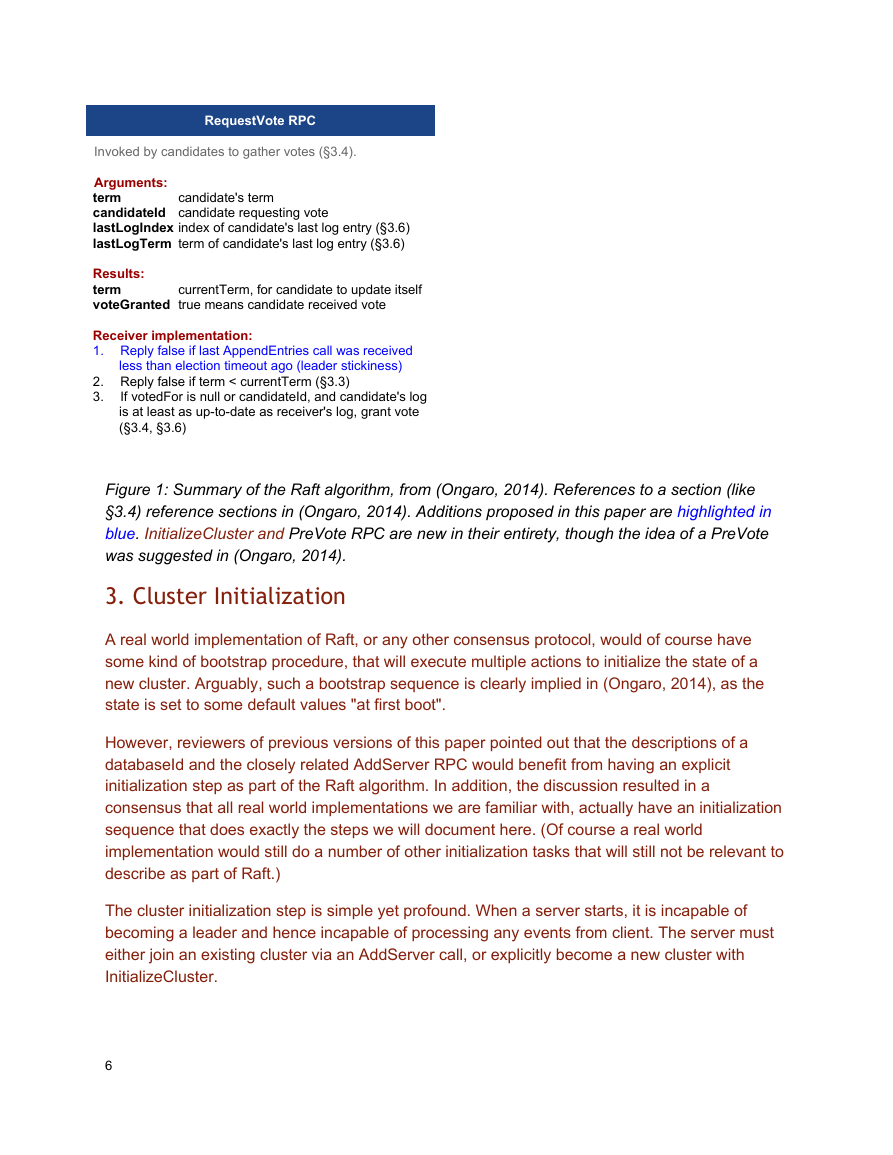
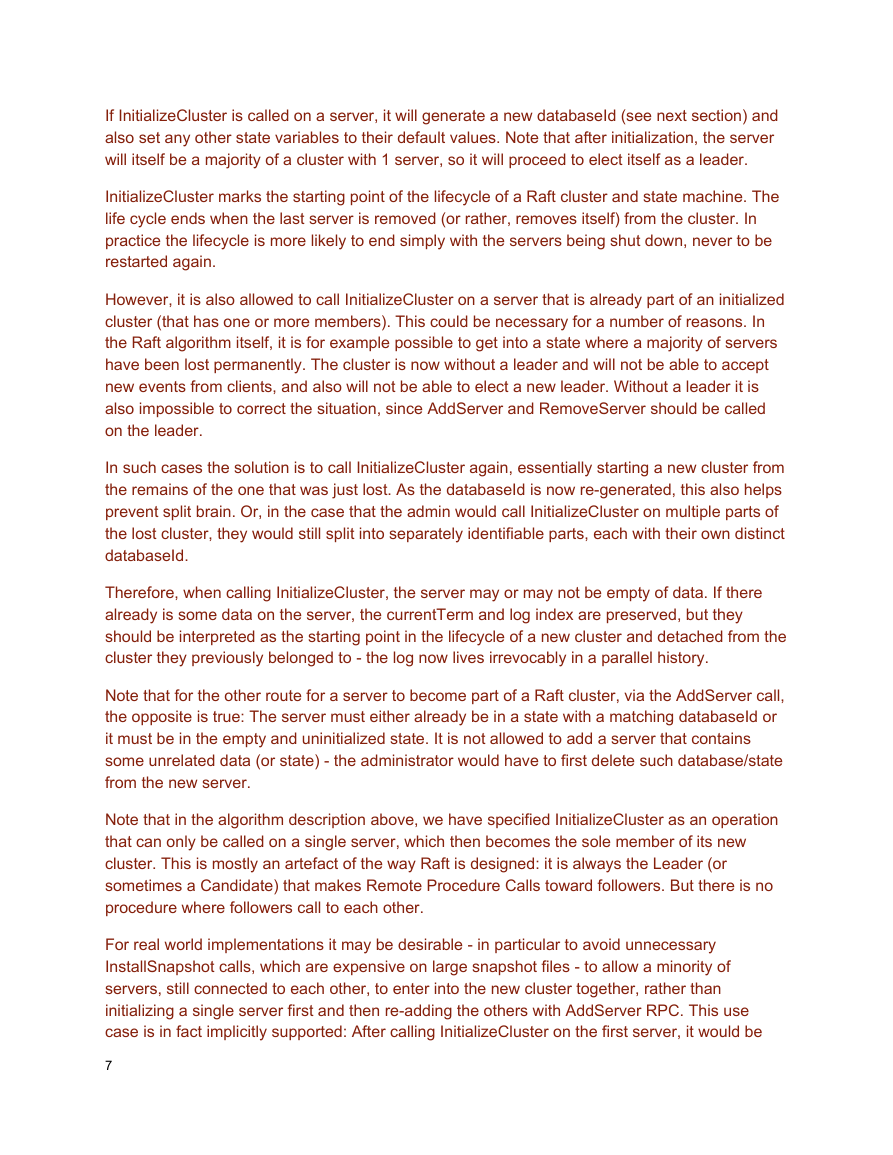
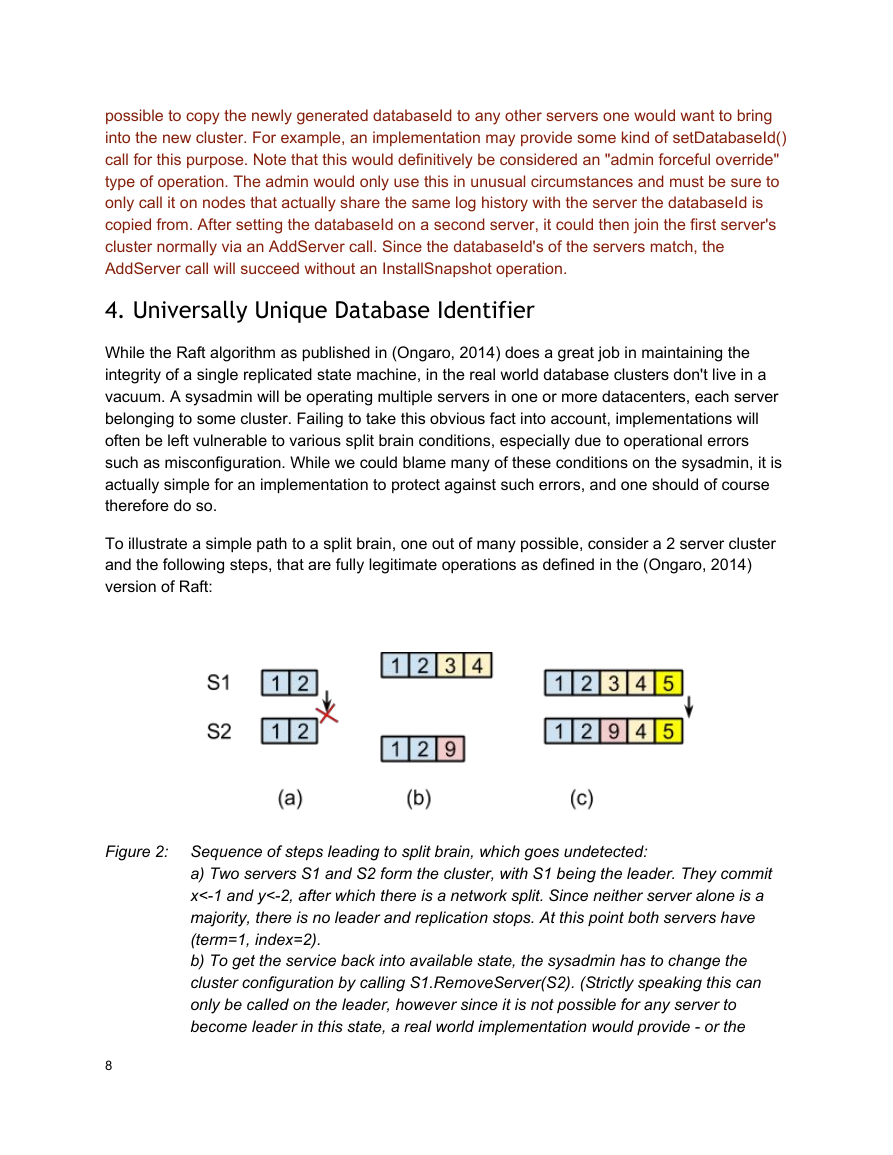








 2023年江西萍乡中考道德与法治真题及答案.doc
2023年江西萍乡中考道德与法治真题及答案.doc 2012年重庆南川中考生物真题及答案.doc
2012年重庆南川中考生物真题及答案.doc 2013年江西师范大学地理学综合及文艺理论基础考研真题.doc
2013年江西师范大学地理学综合及文艺理论基础考研真题.doc 2020年四川甘孜小升初语文真题及答案I卷.doc
2020年四川甘孜小升初语文真题及答案I卷.doc 2020年注册岩土工程师专业基础考试真题及答案.doc
2020年注册岩土工程师专业基础考试真题及答案.doc 2023-2024学年福建省厦门市九年级上学期数学月考试题及答案.doc
2023-2024学年福建省厦门市九年级上学期数学月考试题及答案.doc 2021-2022学年辽宁省沈阳市大东区九年级上学期语文期末试题及答案.doc
2021-2022学年辽宁省沈阳市大东区九年级上学期语文期末试题及答案.doc 2022-2023学年北京东城区初三第一学期物理期末试卷及答案.doc
2022-2023学年北京东城区初三第一学期物理期末试卷及答案.doc 2018上半年江西教师资格初中地理学科知识与教学能力真题及答案.doc
2018上半年江西教师资格初中地理学科知识与教学能力真题及答案.doc 2012年河北国家公务员申论考试真题及答案-省级.doc
2012年河北国家公务员申论考试真题及答案-省级.doc 2020-2021学年江苏省扬州市江都区邵樊片九年级上学期数学第一次质量检测试题及答案.doc
2020-2021学年江苏省扬州市江都区邵樊片九年级上学期数学第一次质量检测试题及答案.doc 2022下半年黑龙江教师资格证中学综合素质真题及答案.doc
2022下半年黑龙江教师资格证中学综合素质真题及答案.doc